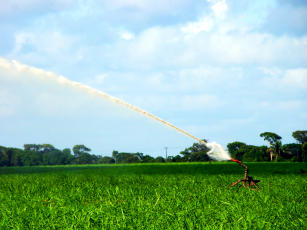Water footprint of sugarcane, ethanol and sugar production in irrigated areas in Brazil
Water footprint of sugarcane, ethanol and sugar production in irrigated areas in Brazil

Photo: NUNES, Saulo Coelho
Brazil’s sugarcane sector plays an important role in the national economy. The country is the world’s biggest producer of sugarcane and sugar, and second in ethanol production, which contributes positively to the trade balance. In the last 15 years, the crop area has expanded tremendously, occupying so called “expansion” production areas, which differ from the traditional ones mainly in rainfall rates, leading producers to adopt irrigation. Specifically in the Northeast region, crops have migrated from the traditional Atlantic forest coastal areas to inland coastal tablelands that suffer long periods of water shortage. Consequently, a significant percentage of the sugarcane production area now employs irrigation. This project was conceived with the objective of quantifying the water volumes required to produce sugar cane, ethanol and sugar in the different irrigated cropping systems in typical Brazilian soil and weather conditions. Estimating water volumes used in producing a given product can be carried out in many ways. The present proposal will employ the methodology developed by Water Footprint Network (Hoekstra et al., 2011) which will be expressed in water volume per product unit, composed of “three types of water”: green (groundwater from rainfall used by plants), blue (fresh surface or groundwater used in production) and grey (water volume required to assimilate the pollutant load generated during production). To reach its overall goal, the project is divided into five Action Plans, to wit: 1) A Managerial Action Plan that, besides normal management activities, includes 01 technical activity named Database, 2) Quantification of Green and Blue Waters, 3) Quantification of Grey Water, 4) Water Footprint by Remote Sensing, and 5) Analysis of Drainage Basins. As it is a network project, the main objective of management will be to supervise technical and administrative-financial activities to guarantee activity cohesion, team harmony and the fulfillment of established goals. Activities are planned to be carried out in the states of Alagoas, Piauí, Bahia, Pernambuco, Sergipe, Mato Grosso do Sul, Goiás, and São Paulo. These states produce over 80% of Brazilian sugarcane. The following results are expected: water volumes used in the production of ethanol, sugar and sugarcane; water volumes of the main users of drainage basins compared to sugarcane; development of a database; comparison between methodologies to quantify water used in ethanol production; knowledge of the possible impacts of sugarcane crops on the water resources of different producing regions. These findings will generate greater knowledge and increased water use efficiency in drainage basins and sugarcane producing areas. The potential effects of the use of various sources of fertilizers and pesticides will be determined.
Ecosystem: Coastal Areas, Atlantic Forest, Cerrados Region
Status: Completed Start date: Sun Jun 01 00:00:00 GMT-03:00 2014 Conclusion date: Thu May 31 00:00:00 GMT-03:00 2018
Head Unit: Embrapa Coastal Tablelands
Project leader: Antonio Dias Santiago
Contact: antonio.santiago@embrapa.br
Keywords: water print, alcool, uso de água, setor sucroalcooleiro
